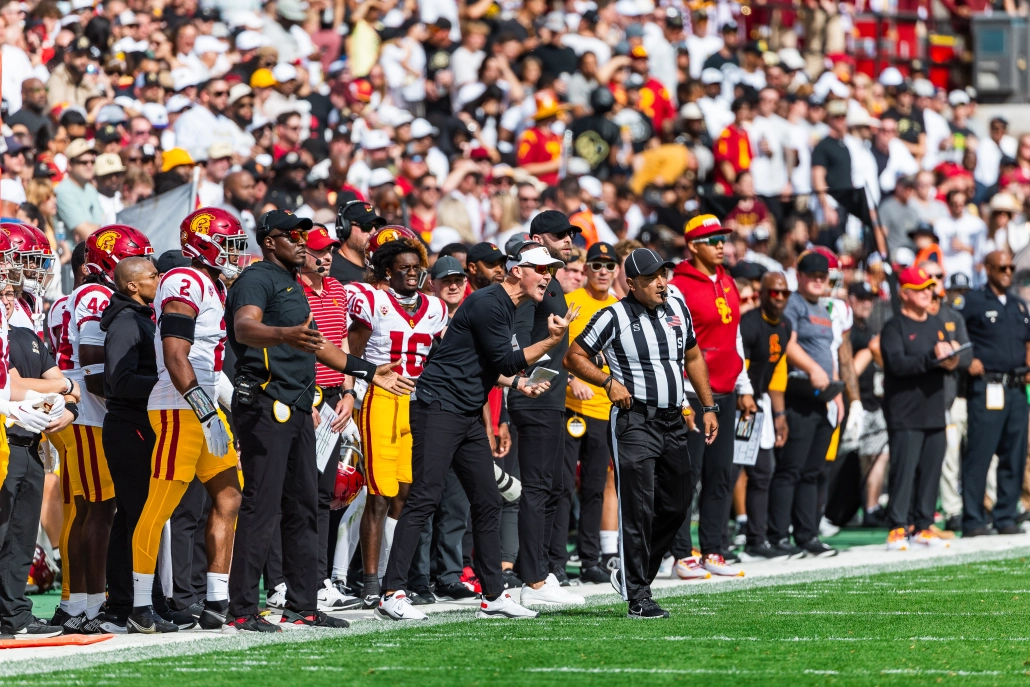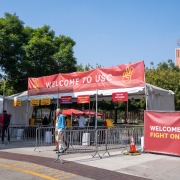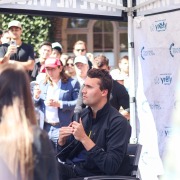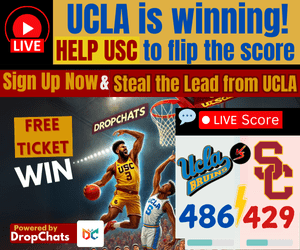Personalities and prospects: the Pac-12’s gasp for rejuvenation
The conference is ending on a high note with its play and excitement this season.
By KASEY KAZLINER

Head Coach Lincoln Riley stands out from the pack, as his Pac-12 counterparts have unleashed fiery emotion in recent interviews. (Louis Chen)
It’s been nearly seven years since Washington clinched a College Football Playoff berth in 2016, the last time a team represented the Pac-12 in the final four. Since then, the conference has struggled to have a team reach the heights of the college football elite and find an identity, especially with the mass exodus of all but two of its members.
In the wake of the conference’s collapse — in possibly its final season — the Pac-12 has risen toward the top regarding media buzz, potential draft names and rankings. Whether it be positive or negative publicity, the Pac-12 is getting something it has desperately needed for a while: attention.
In five of the six college football weeks thus far, the Pac-12 has occupied one of the top two spots in terms of total viewership for a game. While one might attribute this buzz to the success on the gridiron, it is undeniable that certain Pac-12 coaches have influenced the narrative. These coaches have been making names for themselves not just as leaders of the game but as outspoken characters and defenders of their teams’ identities.
While the addition of Head Coach Deion Sanders has changed Colorado’s (3-2, 0-2 Pac-12) football program on the field, it has also added a big personality to a boiling cauldron of angst among other coaches. One example of this came prior to Colorado’s matchup with Oregon (5-0, 2-0), where the Ducks’ Head Coach Dan Lanning told his team that “[Colorado’s] fighting for clicks, we’re fighting for wins,” expressing his clear resentment against a team that has gotten publicity despite being unproven.
The irony of Lanning’s statement is that the real teams “fighting for clicks,” or recognition, rather, are Washington State (4-0, 1-0), and Oregon State (4-1, 1-1). On a recent College GameDay segment, ESPN’s Lee Corso referred to the two teams’ matchup as the “nobody wants us bowl,” in reference to the fact that Oregon State and Washington State still are the lone teams yet to find another conference to join after this season.
Washington State Head Coach Jake Dickert immediately took issue with this statement, saying, “I don’t really understand it. What’s the merit once again?” and “The facts say people watch the Cougs.”
Dickert has reason to be upset; Corso’s comments undermine what Dickert and his team have been able to achieve this season despite having zero five-star recruits and uncertainty about the program’s future. How does this connect to Colorado’s resurgence? Well, Dickert’s frustration with Corso’s words is rooted in the fact that although the Cougars are undefeated, the dichotomy of national recognition between a tried and true program like Washington State and up-and-coming Colorado is immense.
While the drama between the coaches has generated loads of media attention, the star-studded Pac-12 has been dominant on the field. Five Pac-12 quarterbacks are featured in NFL analyst Mel Kiper’s recent top-10 list, a complete contrast to the most recent NFL Draft, where not a single Pac-12 quarterback was drafted. This difference in the conference’s final year, as it is known, has been critical in changing the college football landscape.
The on-field talent has contributed to a multitude of contending Pac-12 teams; USC, Oregon, Washington, Washington State, Oregon State and Utah are all ranked. As far as the remaining teams, only Arizona State and Stanford hold losing records. The Pac-12, a winning conference, has not only generated popularity, but also has a legitimate chance to break its streak of College Football Playoff absences.
While the Pac-12 may not be around for much longer, the conference has left its mark on the 2023 season, one that its personalities, prospects and prosperity will forever define.
DONATION PLUG – PLEASE DO NOT TOUCH
Thank you for reading the Daily Trojan.
We are the only independent newspaper here at USC, run at every level by students. That means we aren’t tied down by any other interests but those of readers like you: the students, faculty, staff and South Central residents that together make up the USC community.
Independence is a double-edged sword: We have a unique lens into the University’s actions and policies, and can hold powerful figures accountable when others cannot. But that also means our budget is severely limited. We’re already spread thin as we compensate the writers, photographers, artists, designers and editors whose incredible work you see in our daily paper; as we work to revamp and expand our digital presence, we now have additional staff making podcasts, videos, webpages, our first ever magazine and social media content, who are at risk of being unable to receive the compensation they deserve.
We are therefore indebted to readers like you, who, by supporting us, help keep our paper daily (we are the only remaining college paper on the West Coast that prints every single weekday), independent, free and widely accessible.
Please consider supporting us. Even $1 goes a long way in supporting our work; if you are able, you can also support us with monthly, or even annual, donations. Thank you.









